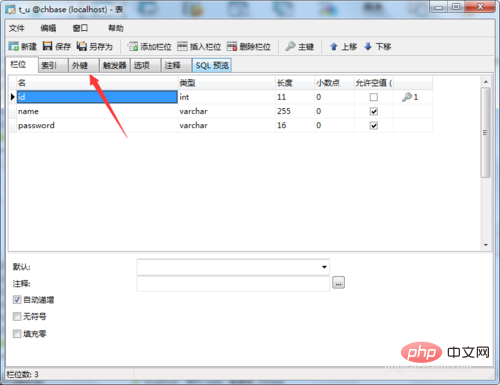How to create foreign keys in navicat

Database foreign keys represent the correlation between two relationships. The table with the foreign key of another relationship as the primary key is called the master table, and the table with the foreign key is called the slave table of the master table. Below we will introduce to you how to create foreign keys in navicat.
Recommended tutorial: MySQL introductory video tutorial
1. Open navicat and select the database table to be operated, right-click and select Design table.

#2. Click the foreign key option to start setting foreign keys.

There are seven columns in total. Let’s briefly introduce the meaning of these columns:
“Name”: You don’t need to fill it in. The system will automatically generate it after you save it successfully.
"Field": It means which key you want to set as a foreign key.
"Reference database": Database associated with foreign keys.
"Reference table": associated table
"Reference field": associated field,
"When deleting": It is the action selected when deleting.
"When updating": It is the action selected when updating.
Extended information: The role of foreign keys
Maintain data consistency and integrity, the main purpose is to control the storage in foreign key tables The data in . To associate two tables, the foreign key can only refer to the values of columns in the table or use null values.
If no foreign key is used, a value (such as 20140999999) is inserted into the student number field of Table 2, but this value does not exist in Table 1. At this time, the database allows the insertion and will not block the inserted value. Data is checked for relationships. However, when setting up a foreign key, the value you insert into the student ID field of Table 2 must be found in the student ID field of Table 1. At the same time, if you want to delete a certain student number field in Table 1, you must ensure that there is no column in Table 2 that references the field value, otherwise it will not be deleted. This is called maintaining data consistency and integrity. As shown on the right, if Table 2 still references a certain student ID in Table 1, but you delete the student ID in Table 1, Table 2 will not know which student the student ID corresponds to.
The tables in the database must comply with the specifications to prevent data redundancy, insertion anomalies, deletion anomalies and other phenomena. The canonical process is the process of decomposing the table. After decomposition, the representative attributes of a thing appear in different tables. Obviously, they should be consistent. For example, the representative data of a student is student number 012, which is 012 in the student table and should also be 012 in the grade table. This consistency is achieved by foreign keys. The function of a foreign key is: its value must be the primary key value of another table. The student number is the primary key in the student table and the foreign key in the grades table. The student number in the grade list must be the student number in the student list. Therefore, the student number in the student table and the student number in the grade table are consistent. It can be intuitively understood that the function of foreign keys is to achieve consistency of signs of the same thing in different tables. 2 Functional realization of two tables connected by foreign keys. When operated separately, the foreign key function is realized by two methods [4]:
Prevent execution
●Insert a new row from the table, and the foreign key value is not the primary key value of the main table, which prevents the insertion;
●Modify the foreign key value from the table, and the new value is not the primary key of the main table The value will prevent modification;
●If a row is deleted from the master table, its primary key value will be prevented from being deleted if it exists in the slave table (if you want to delete it, you must first delete the relevant rows from the slave table);
●The master table modifies the primary key value. If the old value exists in the slave table, the modification is blocked (if you want to modify it, you must first delete the relevant rows from the slave table).
Cascade execution
●Delete rows from the main table, and delete related rows from the table together;
●Modify the primary key value from the main table, Modify the foreign key values of related rows from the table together. Two methods are provided for users to choose. No matter which method is chosen, there will be no extra rows from the table. From another perspective, the same thing is achieved by rejecting the inconsistency between the flags in the slave table and the master table to achieve consistency with the flags in the master table.
●Two implementation methods, choose through the following methods:
●Interface: Set up two selection boxes for cascade update and cascade delete. If selected, the cascade will be executed, and if not selected, it will be blocked. Execution;
●Command: Let E)kSCM)E and RESTRICT be two optional options, CASCADE means cascade execution, and RESTRICT means prevent execution.
The above is the detailed content of How to create foreign keys in navicat. For more information, please follow other related articles on the PHP Chinese website!

Hot AI Tools

Undresser.AI Undress
AI-powered app for creating realistic nude photos

AI Clothes Remover
Online AI tool for removing clothes from photos.

Undress AI Tool
Undress images for free

Clothoff.io
AI clothes remover

AI Hentai Generator
Generate AI Hentai for free.

Hot Article

Hot Tools

Notepad++7.3.1
Easy-to-use and free code editor

SublimeText3 Chinese version
Chinese version, very easy to use

Zend Studio 13.0.1
Powerful PHP integrated development environment

Dreamweaver CS6
Visual web development tools

SublimeText3 Mac version
God-level code editing software (SublimeText3)

Hot Topics
 How to adjust the interface font size in navicat
Apr 24, 2024 pm 04:24 PM
How to adjust the interface font size in navicat
Apr 24, 2024 pm 04:24 PM
Steps to adjust interface font size in Navicat: Enter the required database connection. Click the Tools menu. Select "Options". Select the Environment tab. Under User Interface Settings, find the Font Size setting. Select the desired font size and click OK.
 How to export the er diagram of navicat
Apr 24, 2024 pm 04:21 PM
How to export the er diagram of navicat
Apr 24, 2024 pm 04:21 PM
The steps to export an ER diagram in Navicat are: 1. Open the ER diagram pane; 2. Connect to the database; 3. Export the ER diagram. The exported ER diagram is saved as an image file, showing the entities, relationships, and properties of the database.
 Where is the navicat cache file?
Apr 24, 2024 pm 06:06 PM
Where is the navicat cache file?
Apr 24, 2024 pm 06:06 PM
Navicat cache file storage location: Windows: %APPDATA%\PremiumSoft\Navicat\Cache; Mac: /Users/[username]/Library/Application Support/PremiumSoft/Navicat/Cache. Cache file types: .ncache, .ncache2, .ncache3. Purpose: Store recently opened connections, query history and DBMS metadata. Clear cache files: After closing Navicat, delete the corresponding files in the above location, and then restart Navicat.
 How to copy database to another database in navicat
Apr 24, 2024 pm 07:24 PM
How to copy database to another database in navicat
Apr 24, 2024 pm 07:24 PM
Steps to copy a database using Navicat: Connect the source and target databases. Select the database objects (tables, views, stored procedures) to be copied. Right-click the object and select Copy Database Object. Select the target database and customize replication options (data copy, rename tables, discard constraints). Click "Start" to perform the copy. Check the replication results in the target database to verify the correctness of data and constraints.
 How to export table structure to word using navicat
Apr 24, 2024 pm 07:57 PM
How to export table structure to word using navicat
Apr 24, 2024 pm 07:57 PM
To export a table structure to Word in Navicat: Select the table to export. Select the Export Wizard and select Word format. Custom export options (including table headers, single table export, and merged files). Select the output file location and name. Export and open the file to view the table structure including table names, column names, data types, constraints, and more.
 How to recover accidentally deleted table in navicat
Apr 24, 2024 pm 06:21 PM
How to recover accidentally deleted table in navicat
Apr 24, 2024 pm 06:21 PM
Navicat accidentally deleted table recovery method: Check whether there is an accidentally deleted table in the recycle bin and restore it. Use binary log recovery: open the binary log, find the start and stop positions, recover the table from the binary log file and import it back to the database. Use a third-party backup tool to back up your database regularly, allowing recovery in the event of accidental deletion.
 How to undo the previous step in navicat
Apr 24, 2024 pm 05:48 PM
How to undo the previous step in navicat
Apr 24, 2024 pm 05:48 PM
Navicat can undo the previous operation. The specific steps are as follows: Open Navicat and connect to the database. Perform the action you want to undo. Click the Undo button under the Edit menu in the menu bar (or use the shortcut Ctrl+Z/Cmd+Z). Confirm the undo operation.
 Can Navicat not install the database?
Apr 24, 2024 pm 04:39 PM
Can Navicat not install the database?
Apr 24, 2024 pm 04:39 PM
Navicat is a database management tool that requires a database connection to function. Specifically, it is compatible with database systems such as MySQL, MariaDB, and PostgreSQL, and allows users to perform operations such as querying, creating tables, and modifying data by establishing sessions. Therefore, the database must be installed first, otherwise Navicat cannot be used.






